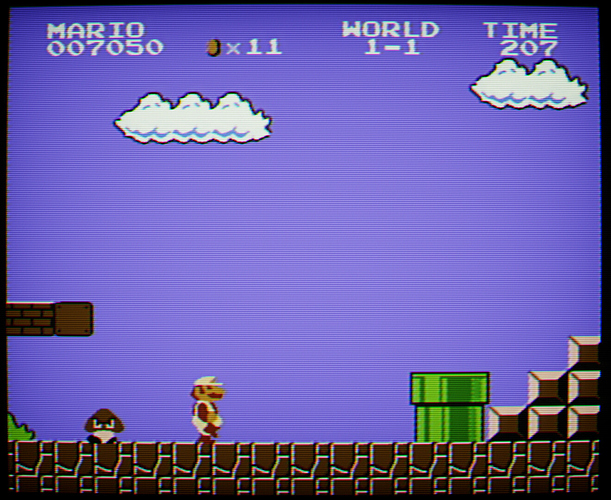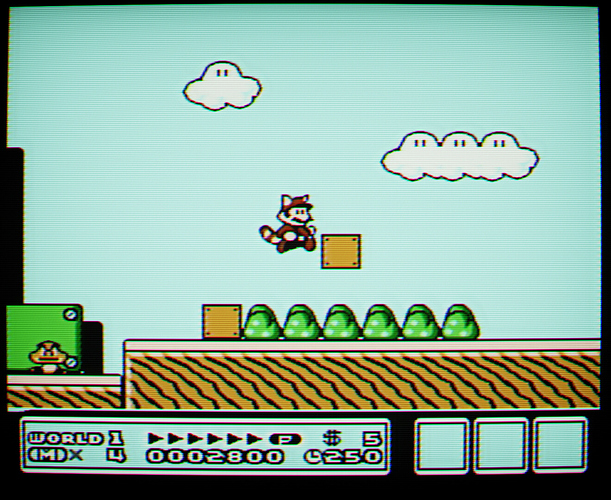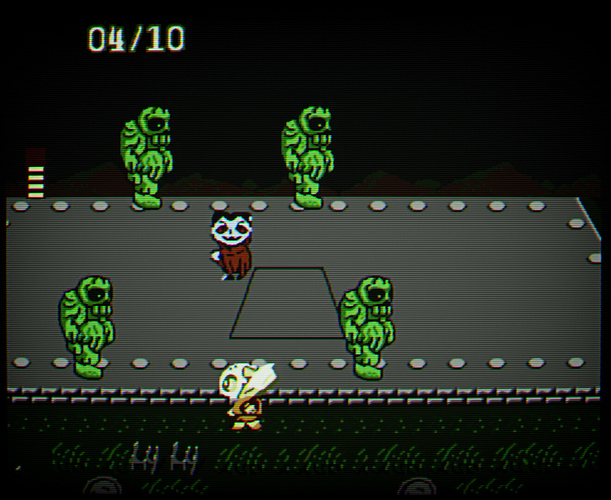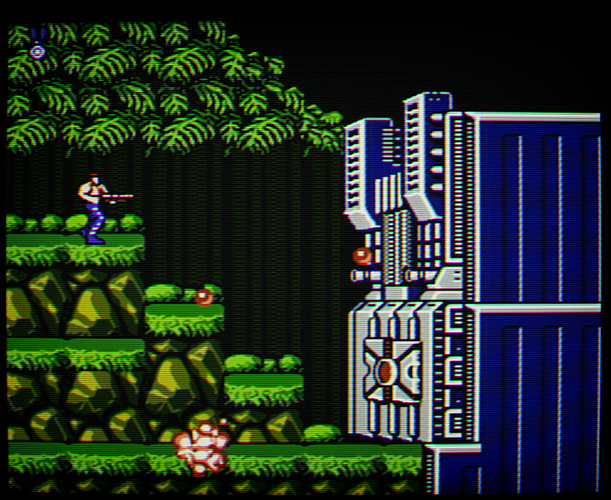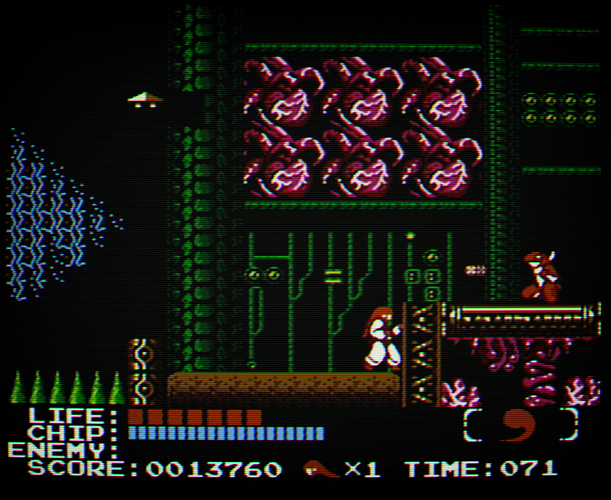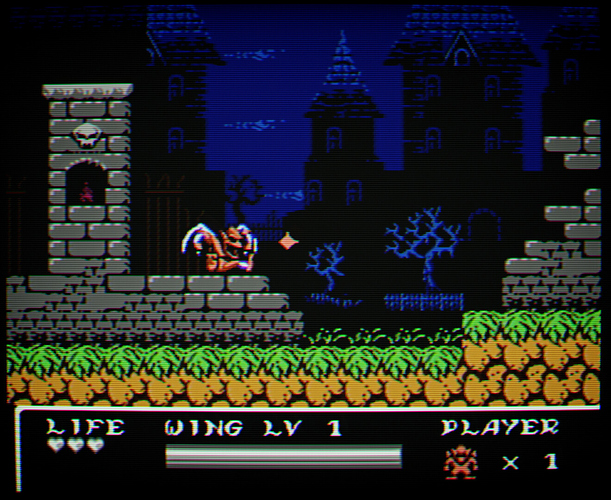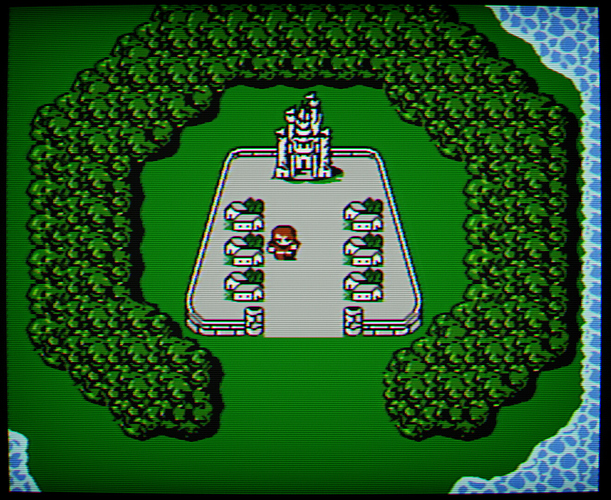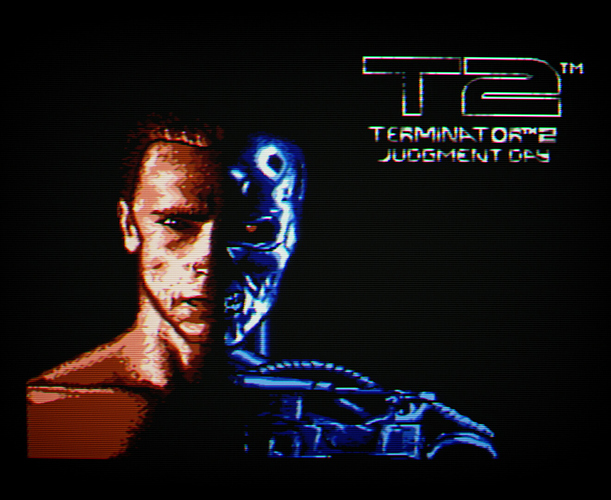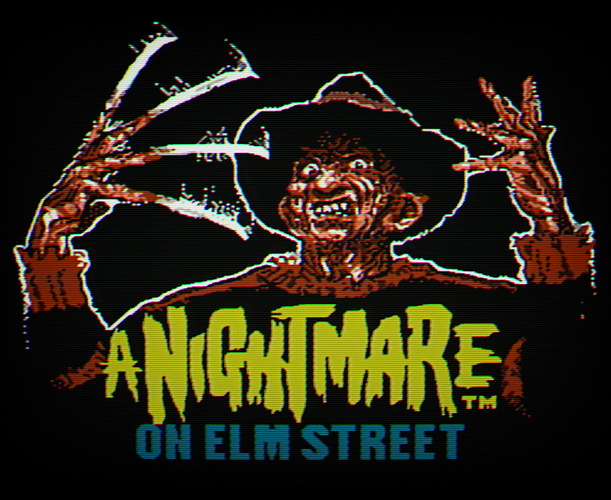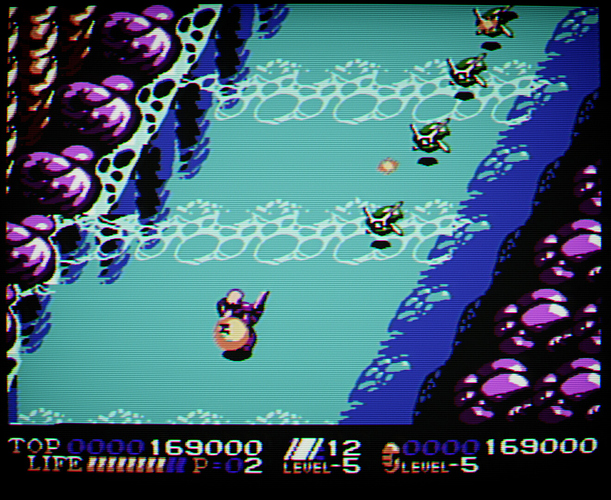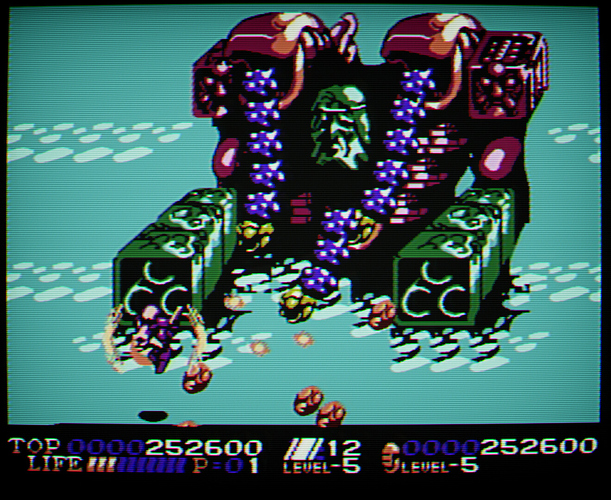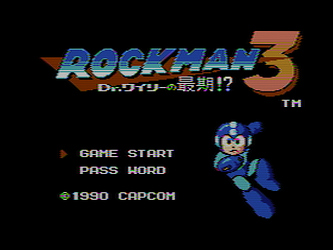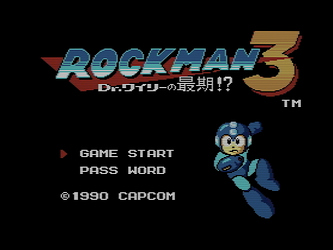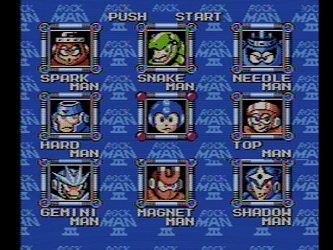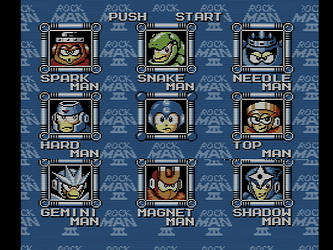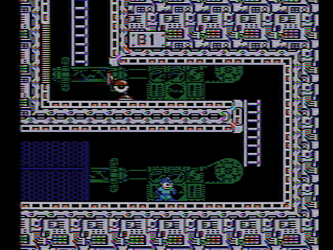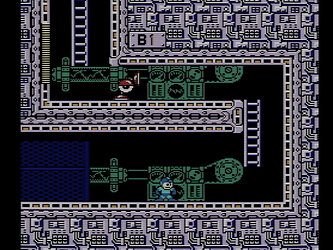An attempt to mimic the evergreen default crt-royale look, extra bloomy, colorful, a dark gamma and extra detailed mask:
You did very well here! Did you know that the original CRT Royale PNGs have some specs of “imperfections” possibly dust and dirt and the phosphor shape is as realistic as it can get?
I think these factors contribute significantly to why CRT-Royale not only looks but feels the way it does!
These look delicious though. Hope the strong mask/cork sniffing ones are labelled for easy locating.
Looking forward to seeing some as accurate as possible HDR ready ones as well!
Just a little screenshot/photo comparison- one of my 100% mask presets (RRGGBBX, Composite Notch Filter) and how it looks on an HDR1000 display. Looks much better in person, of course:
This looks great, love the diagonals. It also highlights one of the reasons that the preset we were testing yesterday was so dark. Just compare the scanline dynamics. This one has thicker scanlines in the dark areas compared to that one.
So does CRT-Guest-Advanced-NTSC now include an emulated notch filter?
Thanks! Yeah lately I’ve been making the bright beams super wide for additional brightness in highlights, I like the way it looks. IMO it’s basically required in order to get the best dynamic range based on how the internal clamping works in guest-advanced, it’s possible I’ve missed something, though.
Not an emulated notch filter, but maybe as close as it gets with guest-ntsc, there’s a bit of wiggle room too for various quality notch filters. I think I’ve identified all of the parameters that would be influenced by notch/comb filtering. A truly emulated notch filter would require a whole new approach than what ntsc-adaptive is doing- the kind of thing PlainOldPants, DariusG and beans are doing.
Visually, one of the key characteristics is that notch filters are quite a bit blurrier than comb filters, you won’t have razor sharp black lines, etc. Another thing worth noting is you don’t get perfectly blended dithering even with notch filters, it’s probably like 80-90% blended (with comb filters even less of a blend).
I have a few reference shots collected on my phone for notch filter, I’ll do a comparison later.
Ok, finding photos of CRTs that are definitely using notch filters is a bit more difficult than I hoped - I collected a few that “look notch,” but couldn’t confirm 100% if that’s the case.
One thing that we’re not emulating is the vertical fringing you get with comb filters - I don’t know why you would ever want that, though. Basically, I’m just trying to eyeball this in some photos I’ve collected - not very scientific.
https://crtdatabase.com/articles/retrotink-composite-decoding
The thing to look for is clean horizontal lines.
I kind of want to say this one from @Jamirus is notch- the horizontal lines are pretty clean and it’s got the stronger chroma bleed.
(How crappy of a TV do you need for composite video artifacts?)
Probably worth distinguishing between a 3d adaptive comb filter (best case composite, e.g., Sony Wega Trinitron) and a 2D comb filter. From my studies, for retro gaming it’s:
3d adaptive comb filter > 3d comb filter > notch filter > 2d comb filter > nothing
Early computer monitors seem to be good candidates, e.g. Commodore 1701 and the Apple II composite displays, although it’s probably troublesome to find something like NES games running on the latter. The Apple II’s output itself seems to be a bit particular. But apparently, it can make differences with filters pretty obvious. (I may have linked that before…but anyway, when scrolling down to “Filtering and Artifact color” there are some pictures, a 3d adaptive filter is supposed to be devastating in this context…and not because it’s turns the picture upside down, that’s addressed in the comments  ).
).
Came up with this after talking to @PlainOldPants for a bit.
NTSC Colors + GTUv50 + guest-advanced-ntsc
-GTUv50 for more accurate YIQ-based Chroma bleed effect
-NTSC color for NTSC color correction (I think that’s what it does?)
-adjusted color temp to -100 (I guess this is 9300k?)
-lowered contrast for aged phosphor “vintage” look
I’m sure there’s some improvement to be made to the settings, particularly fringing/artifacting, but looking at the videos posted here, I think it’s pretty close!
edit: made a few changes so the photos are no longer an exact match, but still close enough. Improved sharpness, artifacting and fringing. A more chroma smeared image will naturally reduce the appearance of dot crawl and fringing, etc - something to keep in mind when adding chroma smear/bleed. Notch filters had the more pronounced chroma smear, while comb filters reduced the chroma smear and made other artifacts like dot crawl and fringing more apparent. This is probably closer to a notch filter.
shaders = "22"
feedback_pass = "0"
shader0 = "shaders_slang/misc/shaders/ntsc-colors.slang"
alias0 = ""
wrap_mode0 = "clamp_to_border"
mipmap_input0 = "false"
float_framebuffer0 = "false"
srgb_framebuffer0 = "false"
scale_type_x0 = "source"
scale_x0 = "1.000000"
scale_type_y0 = "source"
scale_y0 = "1.000000"
shader1 = "shaders_slang/crt/shaders/gtu-v050/pass1.slang"
alias1 = ""
wrap_mode1 = "clamp_to_border"
mipmap_input1 = "false"
float_framebuffer1 = "true"
srgb_framebuffer1 = "false"
scale_type_x1 = "source"
scale_x1 = "1.000000"
scale_type_y1 = "source"
scale_y1 = "1.000000"
shader2 = "shaders_slang/crt/shaders/gtu-v050/pass2.slang"
alias2 = ""
wrap_mode2 = "clamp_to_border"
mipmap_input2 = "false"
filter_linear2 = "false"
float_framebuffer2 = "true"
srgb_framebuffer2 = "false"
scale_type_x2 = "viewport"
scale_x2 = "1.000000"
scale_type_y2 = "source"
scale_y2 = "1.000000"
shader3 = "shaders_slang/crt/shaders/gtu-v050/pass3.slang"
alias3 = ""
wrap_mode3 = "clamp_to_border"
mipmap_input3 = "false"
filter_linear3 = "false"
float_framebuffer3 = "false"
srgb_framebuffer3 = "false"
scale_type_x3 = "viewport"
scale_x3 = "1.000000"
scale_type_y3 = "viewport"
scale_y3 = "1.000000"
shader4 = "shaders_slang/crt/shaders/guest/advanced/stock.slang"
alias4 = ""
wrap_mode4 = "clamp_to_border"
mipmap_input4 = "false"
filter_linear4 = "false"
float_framebuffer4 = "false"
srgb_framebuffer4 = "false"
scale_type_x4 = "source"
scale_x4 = "1.000000"
scale_type_y4 = "source"
scale_y4 = "1.000000"
shader5 = "shaders_slang/crt/shaders/guest/advanced/stock.slang"
alias5 = "StockPass"
wrap_mode5 = "clamp_to_border"
mipmap_input5 = "false"
filter_linear5 = "false"
float_framebuffer5 = "false"
srgb_framebuffer5 = "false"
scale_type_x5 = "source"
scale_x5 = "1.000000"
scale_type_y5 = "source"
scale_y5 = "1.000000"
shader6 = "shaders_slang/crt/shaders/guest/advanced/afterglow0.slang"
alias6 = "AfterglowPass"
wrap_mode6 = "clamp_to_border"
mipmap_input6 = "false"
filter_linear6 = "true"
float_framebuffer6 = "false"
srgb_framebuffer6 = "false"
scale_type_x6 = "source"
scale_x6 = "1.000000"
scale_type_y6 = "source"
scale_y6 = "1.000000"
shader7 = "shaders_slang/crt/shaders/guest/advanced/pre-shaders-afterglow.slang"
alias7 = "PrePass0"
wrap_mode7 = "clamp_to_border"
mipmap_input7 = "false"
filter_linear7 = "true"
float_framebuffer7 = "false"
srgb_framebuffer7 = "false"
scale_type_x7 = "source"
scale_x7 = "1.000000"
scale_type_y7 = "source"
scale_y7 = "1.000000"
shader8 = "shaders_slang/crt/shaders/guest/advanced/ntsc/ntsc-pass1.slang"
alias8 = "NPass1"
wrap_mode8 = "clamp_to_border"
mipmap_input8 = "false"
filter_linear8 = "false"
float_framebuffer8 = "true"
srgb_framebuffer8 = "false"
scale_type_x8 = "source"
scale_x8 = "4.000000"
scale_type_y8 = "source"
scale_y8 = "1.000000"
shader9 = "shaders_slang/crt/shaders/guest/advanced/ntsc/ntsc-pass2.slang"
alias9 = ""
wrap_mode9 = "clamp_to_border"
mipmap_input9 = "false"
filter_linear9 = "true"
float_framebuffer9 = "true"
srgb_framebuffer9 = "false"
scale_type_x9 = "source"
scale_x9 = "0.500000"
scale_type_y9 = "source"
scale_y9 = "1.000000"
shader10 = "shaders_slang/crt/shaders/guest/advanced/ntsc/ntsc-pass3.slang"
alias10 = ""
wrap_mode10 = "clamp_to_border"
mipmap_input10 = "false"
filter_linear10 = "true"
float_framebuffer10 = "false"
srgb_framebuffer10 = "false"
scale_type_x10 = "source"
scale_x10 = "1.000000"
scale_type_y10 = "source"
scale_y10 = "1.000000"
shader11 = "shaders_slang/crt/shaders/guest/advanced/custom-fast-sharpen.slang"
alias11 = "NtscPass"
wrap_mode11 = "clamp_to_border"
mipmap_input11 = "false"
filter_linear11 = "true"
float_framebuffer11 = "false"
srgb_framebuffer11 = "false"
scale_type_x11 = "source"
scale_x11 = "1.000000"
scale_type_y11 = "source"
scale_y11 = "1.000000"
shader12 = "shaders_slang/crt/shaders/guest/advanced/stock.slang"
alias12 = "PrePass"
wrap_mode12 = "clamp_to_border"
mipmap_input12 = "true"
filter_linear12 = "true"
float_framebuffer12 = "false"
srgb_framebuffer12 = "false"
scale_type_x12 = "source"
scale_x12 = "1.000000"
scale_type_y12 = "source"
scale_y12 = "1.000000"
shader13 = "shaders_slang/crt/shaders/guest/advanced/avg-lum-ntsc.slang"
alias13 = "AvgLumPass"
wrap_mode13 = "clamp_to_border"
mipmap_input13 = "true"
filter_linear13 = "true"
float_framebuffer13 = "false"
srgb_framebuffer13 = "false"
scale_type_x13 = "source"
scale_x13 = "1.000000"
scale_type_y13 = "source"
scale_y13 = "1.000000"
shader14 = "shaders_slang/crt/shaders/guest/advanced/linearize-ntsc.slang"
alias14 = "LinearizePass"
wrap_mode14 = "clamp_to_border"
mipmap_input14 = "false"
filter_linear14 = "true"
float_framebuffer14 = "true"
srgb_framebuffer14 = "false"
scale_type_x14 = "source"
scale_x14 = "1.000000"
scale_type_y14 = "source"
scale_y14 = "1.000000"
shader15 = "shaders_slang/crt/shaders/guest/advanced/crt-guest-advanced-ntsc-pass1.slang"
alias15 = "Pass1"
wrap_mode15 = "clamp_to_border"
mipmap_input15 = "false"
filter_linear15 = "true"
float_framebuffer15 = "true"
srgb_framebuffer15 = "false"
scale_type_x15 = "viewport"
scale_x15 = "1.000000"
scale_type_y15 = "source"
scale_y15 = "1.000000"
shader16 = "shaders_slang/crt/shaders/guest/hd/gaussian_horizontal.slang"
alias16 = ""
wrap_mode16 = "clamp_to_border"
mipmap_input16 = "false"
filter_linear16 = "true"
float_framebuffer16 = "true"
srgb_framebuffer16 = "false"
scale_type_x16 = "absolute"
scale_x16 = "800"
scale_type_y16 = "source"
scale_y16 = "1.000000"
shader17 = "shaders_slang/crt/shaders/guest/advanced/gaussian_vertical.slang"
alias17 = "GlowPass"
wrap_mode17 = "clamp_to_border"
mipmap_input17 = "false"
filter_linear17 = "true"
float_framebuffer17 = "true"
srgb_framebuffer17 = "false"
scale_type_x17 = "absolute"
scale_x17 = "800"
scale_type_y17 = "absolute"
scale_y17 = "600"
shader18 = "shaders_slang/crt/shaders/guest/hd/bloom_horizontal.slang"
alias18 = ""
wrap_mode18 = "clamp_to_border"
mipmap_input18 = "false"
filter_linear18 = "true"
float_framebuffer18 = "true"
srgb_framebuffer18 = "false"
scale_type_x18 = "absolute"
scale_x18 = "800"
scale_type_y18 = "absolute"
scale_y18 = "600"
shader19 = "shaders_slang/crt/shaders/guest/advanced/bloom_vertical.slang"
alias19 = "BloomPass"
wrap_mode19 = "clamp_to_border"
mipmap_input19 = "false"
filter_linear19 = "true"
float_framebuffer19 = "true"
srgb_framebuffer19 = "false"
scale_type_x19 = "absolute"
scale_x19 = "800"
scale_type_y19 = "absolute"
scale_y19 = "600"
shader20 = "shaders_slang/crt/shaders/guest/advanced/crt-guest-advanced-ntsc-pass2.slang"
alias20 = ""
wrap_mode20 = "clamp_to_border"
mipmap_input20 = "false"
filter_linear20 = "true"
float_framebuffer20 = "true"
srgb_framebuffer20 = "false"
scale_type_x20 = "viewport"
scale_x20 = "1.000000"
scale_type_y20 = "viewport"
scale_y20 = "1.000000"
shader21 = "shaders_slang/crt/shaders/guest/advanced/deconvergence-ntsc.slang"
alias21 = ""
wrap_mode21 = "clamp_to_border"
mipmap_input21 = "false"
filter_linear21 = "true"
float_framebuffer21 = "false"
srgb_framebuffer21 = "false"
scale_type_x21 = "viewport"
scale_x21 = "1.000000"
scale_type_y21 = "viewport"
scale_y21 = "1.000000"
compositeConnection = "1.000000"
signalResolution = "512.000000"
signalResolutionI = "84.000000"
signalResolutionQ = "26.000000"
tvVerticalResolution = "240.000000"
contrast = "0.900000"
WP = "-100.000000"
sega_fix = "1.000000"
cust_artifacting = "1.000000"
cust_fringing = "1.000000"
ntsc_cscale = "4.000000"
ntsc_cscale1 = "2.250000"
ntsc_shape = "0.500000"
CSHARPEN = "1.000000"
CCONTR = "0.250000"
DEBLUR = "3.500000"
GAMMA_INPUT = "2.400000"
gamma_out = "2.400000"
interm = "3.000000"
HSHARPNESS = "1.199999"
SIGMA_HOR = "0.500000"
S_SHARP = "1.500002"
HSHARP = "1.400000"
MAXS = "0.220000"
HARNG = "0.200000"
m_glow = "2.000000"
glow = "0.000000"
gsl = "2.000000"
scanline1 = "5.000000"
scanline2 = "70.000000"
beam_min = "1.000000"
beam_max = "0.600000"
beam_size = "0.000000"
scans = "1.000000"
shadowMask = "12.000000"
maskstr = "1.000000"
mcut = "1.000000"
deconrry = "1.000000"
deconrby = "-1.000000"
textures = "SamplerLUT1;SamplerLUT2;SamplerLUT3;SamplerLUT4"
SamplerLUT1 = "shaders_slang/crt/shaders/guest/advanced/lut/trinitron-lut.png"
SamplerLUT1_mipmap = "false"
SamplerLUT1_wrap_mode = "clamp_to_border"
SamplerLUT2 = "shaders_slang/crt/shaders/guest/advanced/lut/inv-trinitron-lut.png"
SamplerLUT2_mipmap = "false"
SamplerLUT2_wrap_mode = "clamp_to_border"
SamplerLUT3 = "shaders_slang/crt/shaders/guest/advanced/lut/nec-lut.png"
SamplerLUT3_mipmap = "false"
SamplerLUT3_wrap_mode = "clamp_to_border"
SamplerLUT4 = "shaders_slang/crt/shaders/guest/advanced/lut/ntsc-lut.png"
SamplerLUT4_mipmap = "false"
SamplerLUT4_wrap_mode = "clamp_to_border"-NTSC color for NTSC color correction (I think that’s what it does?)
That’s a good opportunity then to clarify what it does vs. what other options do like Blargg filters and the shaders by @Guest and others (how does the NTSC LUT compare?)
Also, does it make a difference for content (hardware) that uses non-RGB palettes (NES, Atari 8-bit consoles and computers, C64 etc…) versus RGB generated? I wonder if there are scenarios where you are correcting essentially twice.
Hey there,
Still trying to prepend various stuff like NTSC-adaptative and scaleFX for NewPixie. I use 1080p, seems the rolling scanlines are set to fit that resolution. Is there a way to adapt the shader to QHD or 4K in the parameters? There’s no Y-resolution parameter, so when trying on those resolutions, the scanlines are a bit too thin for my taste.
Having a blast from the past right now with Isolated Warrior, my favourite game on the NES… Look at this guy, old friend of mine…
Good point, yes, I think you’re double correcting with those consoles when you select an NTSC palette- the palette should already be “corrected,” right? Any palette based on the final displayed image on a CRT doesn’t need to be corrected again…
Turbografx 16 is interesting, it did its own internal correction with a LUT to convert RGB to composite video colors before sending the signal to the TV, so the colors stay fairly consistent when switching from RGB and composite.
Nice! What’s that game?
Yeah the design is really cool. It’s a boss from NES game “Isolated Warrior”.
Guest-advanced-ntsc + GTUv50 + NTSC colors, adjusted to 9300k, 4k HDR1000, adjusted for Trinitron-like sharpness while fully blending dithering:
Threw together this quick comparison in guest-advanced-ntsc (can only be viewed correctly on an HDR1000 monitor; please forgive the darkness otherwise)
Composite
S-video
RGB
Hey there!
This week’s tweak got me playing some GameBoy Color titles. I’m a sucker for the retroachievement event and this month’s Zelda Oracle of Season is prescribed, so I’ll play that, to praise and please goddess Cheevos.
The shader chain comprise a LCD time response motion blur for transparency sprites based on blinking (I found it looked better to me than the built in motion blur in some cores when using the next shaders on top), JINC2 and ScaleFX for upscaling, GBC color correction and then CRT-Guest-Advanced-NTSC. Thanks you guys so much for all that. Here are some pics in 1080p and a download link if you want to test that, you can set CRT mask size and zoom parameters to your liking and resolution within the shader params ofc.
https://mega.nz/file/GBAwwSyI#xa8aPAjKrpbbiz5PmOjrp5RWYOkgirLVcGmdmIYBdvA
Hello my old friends and all the “new” people that share the love for CRT simulations. I finally got myself a new computer, and can run all the shaders properly at big resolutions. Was really looking forward to this. By courtesy of guest’s insane shader, enter Pulstar 
To my eyes, it just doesn’t get better than this.
Hey there!
Played some NES games this week. Mesen core with composite by FirebrandX palette, and a preset mixing JINC2, ScaleFX, NTSC adaptive and NewPixie on top. You can get the preset for 1080p here if you want a go at it :
https://mega.nz/file/WR5UVALQ#XQPzdqNUuNiTxHXSAHEkGWkvF2OK-InG9ToxL8sP5as
Here are more screenshots demonstrating the WIP effort on the Scanline Classic shader. https://forums.libretro.com/t/the-scanline-classic-shader/41497/13?u=anikom15
I attempted to mimic the S-Video output from the Famicom Titler. The desaturation of colors is due to the belief that the titler cuts the chroma signal by 50%, as described here: https://www.nesdev.org/wiki/X0858CE
The result appears to be somewhat of an overcorrection. I am comparing it to what a composite NES might look like using the WIP composite mode of my shader and the ‘feedback filter’. Note that the screenshots look more filthy than what it looks like while running because the fields blur together and reduce the strength of the rainbow colors.

















